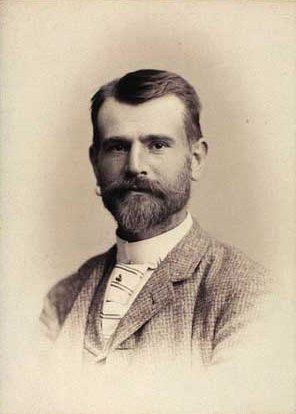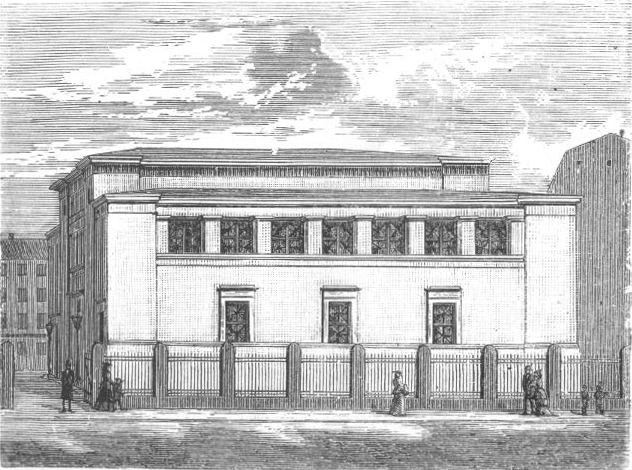|
Ny Kongensgade
Ny Kongensgade (literally "New King's Street) is a street in central Copenhagen, Denmark, connecting Frederiksholm Canal to H. C. Andersens Boulevard. In the opposite direction, The Prince's Bridge connects the street to Tøjhusgade on Slotsholmen. History The first houses along the street were built in about 1670 when it was known as Prindsensgade. It is unknown when the name was changed but it is referred to as Nye Kongensgade on Gedde's Map of Copenhagen from 1757. The original street only reached as far as the Western Rampart at present day Vester Voldgade, then a narrow alley on the inside of the rampart, connecting Vartov to the coast. When that portion of the Fortification Ring was finally decommissioned in 1885, as one of the last to be so, Ny Kongensgade was extended to Vester Boulevard (now H. C. Andersens Boulevard). Håndværkerstiftelsen opened on the corner of Ny Kongensgade and Vester Voldgade on 1 August 1887, providing affordable accommodation for elderly cra ... [...More Info...] [...Related Items...] OR: [Wikipedia] [Google] [Baidu] |
Copenhagen
Copenhagen ( or .; da, København ) is the capital and most populous city of Denmark, with a proper population of around 815.000 in the last quarter of 2022; and some 1.370,000 in the urban area; and the wider Copenhagen metropolitan area has 2,057,142 people. Copenhagen is on the islands of Zealand and Amager, separated from Malmö, Sweden, by the Øresund strait. The Øresund Bridge connects the two cities by rail and road. Originally a Viking fishing village established in the 10th century in the vicinity of what is now Gammel Strand, Copenhagen became the capital of Denmark in the early 15th century. Beginning in the 17th century, it consolidated its position as a regional centre of power with its institutions, defences, and armed forces. During the Renaissance the city served as the de facto capital of the Kalmar Union, being the seat of monarchy, governing the majority of the present day Nordic region in a personal union with Sweden and Norway ruled by the Danis ... [...More Info...] [...Related Items...] OR: [Wikipedia] [Google] [Baidu] |
Barchmann Mansion
Barchmann Mansion () is a Baroque style town mansion overlooking Frederiksholm Canal in central Copenhagen, Denmark. Built in the early 1740s to designs by Philip de Lange, it is also known as the Wedell Mansion (Danish: ''Wedells Palæ'') after the current owner. It was listed in the Danish registry of protected buildings and places in 1918. An extension from 1748 is now home to Johan Borup's Folk High School. History Bachmann The property was listed in Copenhagen's first cadastre of 1689 as No. 295 in the West Quarter, owned by ''fodermarskal'' Søren Jensen. The house was built in 1740–41 by Philip de Lange for affluent Jacob Barchmann. Barchmann did not live in it himself but rented it out to foreign envoys. The original building was extended in 1748, first along the canal and a little later along Ny Kongensgade. Barchmann's property was listed in the new cadastre of 1756 as No. 243 in the Qest Quarter. His widow kept the properties after her husband's death. Changin ... [...More Info...] [...Related Items...] OR: [Wikipedia] [Google] [Baidu] |
Axel Berg (architect)
Emil Axel Berg (5 August 1856 – 10 December 1929) was a Danish architect. He received the Neuhausen Prize, C. F. Hansen Medal, and Eckersberg Medal, and was honored as a Knight of Order of the Dannebrog. Early years Born in Copenhagen, Berg was the son of weight manufacturer, and captain in the Copenhagen Fire Brigade, Vilhelm Julius Berg and Caroline Frederikke Albine Bruun. He studied carpentry when he was 16 but a year later, in 1873, he began studying architecture. He graduated at the Technical University of Denmark in 1877 and at the Royal Danish Academy in December 1880.Rikke Tønnes, "Axel Berg" ''Kunstindekx Danmark & Weilbachs kunstnerleksikon''. Retrieved 13 December 2012. Career Berg, who practiced a |
Krystalgade
Krystalgade (literally "Crystal Street") is a street in central Copenhagen, Denmark, connecting Nørregade to Købmagergade. Copenhagen Central Library and the Great Synagogue (Copenhagen), Great Synagogue of Copenhagen are located in the street. History The street is mentioned in 1492 as "a small alley leading to Cabtor's gate" and again in 1528 as "the alley to the rear of Cantor's gate reaching from Nørregade to Købmagergade". From 1600, it is referred to as Skidenstræde (''Schiden Strede''), literally "Shitty Alley", probably due to the odeur from a covered sewer which passed under it. It was divided into Store Skidenstræde ("Great Shitty Street") and Lille Skidenstræde ("Little Shitty Street"), located west and east of Fiolstræde respectively. University of Copenhagen's first botanical garden was located on the south side of Store Skidenstræde. At some point, Store Skidenstræde became colloquially known as Krystalgade. The name (''Cristal Gade'') is seen on Gedde's ... [...More Info...] [...Related Items...] OR: [Wikipedia] [Google] [Baidu] |
Great Synagogue (Copenhagen)
The Great Synagogue is the main synagogue of the Jewish community in Copenhagen, Denmark. The synagogue is defined by its unique architecture around the Ark. During the first half of the 19th century, synagogues continued to be built in the classical tradition, but there began to be a revival of Greek and Roman architecture. The Great Synagogue in Copenhagen is one of a few synagogues of its period to use Egyptian elements in the columns, ceiling and cornice over the ark. History Arrival of Jews into Denmark Jews were first welcomed into Denmark in 1622 when they were invited into the country by Denmark's king. Although they were scattered around, many of the Jews settled in Copenhagen. Abraham Salomon became the first rabbi in the country in 1687. From 1766 until 1795, around 1,500 Jews worshipped in a small synagogue until it burned down. After the synagogue burned down, a division occurred between the orthodox and progressive members of the Jewish community. As a result, th ... [...More Info...] [...Related Items...] OR: [Wikipedia] [Google] [Baidu] |
Akvavit
''Akvavit'' or ''aquavit'' (; also ''akevitt'' in Norwegian; ''aquavit'' in English) is a distilled spirit that is principally produced in Scandinavia, where it has been produced since the 15th century. ''Akvavit'' is distilled from grain or potatoes, and is flavoured with a variety of herbs. It is also popular in Northern Germany. ''Akvavit'' gets its distinctive flavour from spices and herbs, and the dominant flavour must (according to the European Union) come from a distillate of caraway and/or dill seed. It typically contains 40% alcohol by volume or 80 proof (U.S.) The EU has established a minimum of 37.5% ABV for ''akvavit'' to be named as such. Etymology The word ''aquavit'' derives from the Latin ''aqua vitae'', "water of life." Compare the words ''whisky'' or ''whiskey'', from Gaelic ''uisce beatha'', which has the same meaning. Likewise, clear fruit brandy is called ''eau de vie'' ( French for "water of life"). Drinking culture Akvavit is an important part of Nordic d ... [...More Info...] [...Related Items...] OR: [Wikipedia] [Google] [Baidu] |
Philip De Lange
Philip de Lange (c. 1705 – 17 September 1766) was a leading Dutch-Danish architect who designed many different types of building in various styles including Dutch Baroque and Rococo. Early life and family Philip de Lange was probably born near Strasbourg and was trained as a mason in the Netherlands. He arrived in Copenhagen, Denmark, in 1729 where he quickly gained a reputation as an architect and master builder. Achievements De Lange created a large number of works of various types including civil and military buildings, mansions, country houses, warehouses, factories, churches and parks. The Dutch Baroque influence in his early work can, for example, be seen in the premises he built for Ziegler, the pastry cook, at Nybrogade 12 (1732). While initially he appears to have been struck by Ewert Janssen's earlier work, he soon seems to have been influenced by Elias Häusser and Lauritz de Thurah. Like Krieger, he participated strongly in creating fine bourgeois dwellin ... [...More Info...] [...Related Items...] OR: [Wikipedia] [Google] [Baidu] |
Ny Kongensgade 5
Ny Kongensgade 5 is an 18th-century property located in the small Frederiksholm Neighborhood of central Copenhagen, Denmark. The building shares a small courtyard with Ny Kongensgade 7. It was listed in the Danish registry of protected buildings and places in 1950. History 18th century The Frederiksholm quarter was created on reclaimed land in the 1660s. The property was formerly part of a larger property, listed in Copenhagen's first cadastre of 1689 as No. 294 in the cityøs West Quarter. It was owned by Christen Jensen at that time. The property was later divided into what is now Ny Kongensgade 3-5 and Ny Kongensgade 7. The present building on the site was built as a distiller's house before 1732. The area escaped the devastating Copenhagen Fire of 1728 and the building may therefore predate this year. The owners operated a distillery in the courtyard. In 1751, it was owned by a distiller named Christen Nielsen. His property was listed in the new cadastre of 1756 as ... [...More Info...] [...Related Items...] OR: [Wikipedia] [Google] [Baidu] |
Denmark
) , song = ( en, "King Christian stood by the lofty mast") , song_type = National and royal anthem , image_map = EU-Denmark.svg , map_caption = , subdivision_type = Sovereign state , subdivision_name = Danish Realm, Kingdom of Denmark , established_title = History of Denmark#Middle ages, Consolidation , established_date = 8th century , established_title2 = Christianization , established_date2 = 965 , established_title3 = , established_date3 = 5 June 1849 , established_title4 = Faroese home rule , established_date4 = 24 March 1948 , established_title5 = European Economic Community, EEC 1973 enlargement of the European Communities, accession , established_date5 = 1 January 1973 , established_title6 = Greenlandic home rule , established_date6 = 1 May 1979 , official_languages = Danish language, Danish , languages_type = Regional languages , languages_sub = yes , languages = German language, GermanGerman is recognised as a protected minority language in t ... [...More Info...] [...Related Items...] OR: [Wikipedia] [Google] [Baidu] |
Ny Kongensgade (1757)
Ny Kongensgade (literally "New King's Street) is a street in central Copenhagen, Denmark, connecting Frederiksholm Canal to H. C. Andersens Boulevard. In the opposite direction, The Prince's Bridge connects the street to Tøjhusgade on Slotsholmen. History The first houses along the street were built in about 1670 when it was known as Prindsensgade. It is unknown when the name was changed but it is referred to as Nye Kongensgade on Gedde's Map of Copenhagen from 1757. The original street only reached as far as the Western Rampart at present day Vester Voldgade, then a narrow alley on the inside of the rampart, connecting Vartov to the coast. When that portion of the Fortification Ring was finally decommissioned in 1885, as one of the last to be so, Ny Kongensgade was extended to Vester Boulevard (now H. C. Andersens Boulevard). Håndværkerstiftelsen opened on the corner of Ny Kongensgade and Vester Voldgade on 1 August 1887, providing affordable accommodation for elderly cr ... [...More Info...] [...Related Items...] OR: [Wikipedia] [Google] [Baidu] |




